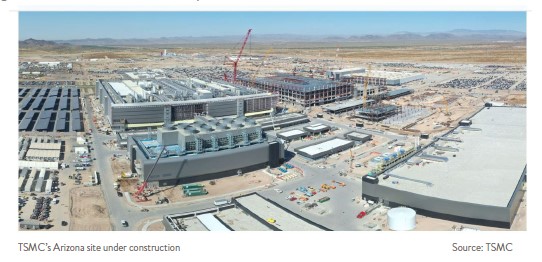Taiwan Semiconductor Manufacturing Company, or TSMC, the world’s largest contract maker of semiconductors, has long exercised world domination in the manufacture of leading-edge chips from the small island of Taiwan. Only in recent years — as geopolitical rivalry has intensified — has TSMC started venturing beyond Taiwan and its two lesser facilities in mainland China. Whether it can transfer its world-beating ways beyond its borders — to Japan, Germany, and the U.S. — is yet to be seen. But at least in its early days in Arizona, stepping out of Taiwan hasn’t been easy.
When TSMC first announced it would invest $12 billion into a new fab (semiconductor fabricating facility) outside of Phoenix in 2020, it was very welcome news for the U.S., which has been vigorously pushing to bring more chip manufacturing back onshore. It also was good news when TSMC increased its commitment to $40 billion and a second fab in 2022 – and then in April of this year to $65 billion and a third fab, thanks to funding from the CHIPS and Science Act.

But along the way, there have been stumbles and delays. Construction in the U.S. is slower and more expensive than in Taiwan. TSMC had to push the opening of its first Arizona fab from 2024 to 2025 — and for the second fab from 2026 to 2028. In an early 2023 call with investors, TSMC noted “some challenges in obtaining permits.” The next quarter, it highlighted a much larger problem — “an insufficient amount of skilled workers with the specialized expertise required for equipment installation in a semiconductor-grade facility.” TSMC’s solution was to send experienced technicians from Taiwan to Arizona. At the same time, it ramped up hiring in the U.S. and sent many of its newly hired American employees to Taiwan for training and acculturation.
While things in Arizona have turned more positive recently, it’s been widely reported that getting the Americans and Taiwanese on the same page was a struggle. An article by Viola Chou called “TSMC’s debacle in the American desert” describes cultural breakdowns on both sides. The Taiwanese complained the Americans didn’t work hard enough. The American engineers found it difficult to do so when crucial meetings and documents were only in Mandarin or Taiwanese. The Americans had to learn it wasn’t customary to ask or try to understand why they were doing what they were asked to do – but to just do it. The Taiwanese had to learn that “Americans responded better to encouragement rather than criticism.” According to Chou’s story, when an American asked a Taiwanese manager what the top priority was, the answer was always, “Everything is a priority.”
These cultural rifts would come as no surprise to Morris Chang, who founded TSMC in 1987 after spending decades in the U.S. at Texas Instruments. In a 2021 talk, Chang said, “Computers of different brands can often be hooked together, but not people of different culture.” He also said, “The fact that TSMC’s top-flight executives can deliver top results in Taiwan is no guarantee of similar performance when they are posted overseas.”
Chang has always been doubtful of the U.S. succeeding at chip manufacturing – because of higher costs, skills deficits, and a work ethic that frankly falls short of Taiwan’s. “If a piece of equipment breaks down at one o’clock in the morning,” he once said, “then in the U.S., it will be fixed by nine. In Taiwan, however, it will be fixed at two a.m.”
It’s hard not to compare Arizona with TSMC’s experience in Japan, where it opened a new fab in Kumamoto earlier this year on time and without a hitch. And you may or may not agree with what Morris Chang says about cultural differences between the U.S. and Taiwan. But it’s hard to disagree that some part of TSMC’s success comes from a finely tuned ecosystem in Taiwan that has developed over decades. Taiwan is a small island with an efficient high-speed rail system. TSMC’s well-established connections between headquarters in Hsinchu and plants in Taichung and Tainan mean engineers and resources can easily be shifted among sites. TSMC also has had decades of experience managing tightly integrated, complex relationships with suppliers and customers – not something that’s easy to replicate. Just ask China, which has poured billions into developing a domestic industry but found that money is not enough to get to the leading edge. Or ask struggling Intel. As NVIDIA’s founder Jensen Huang once said, over the years TSMC has learned to dance with 400 partners while Intel has always danced alone.